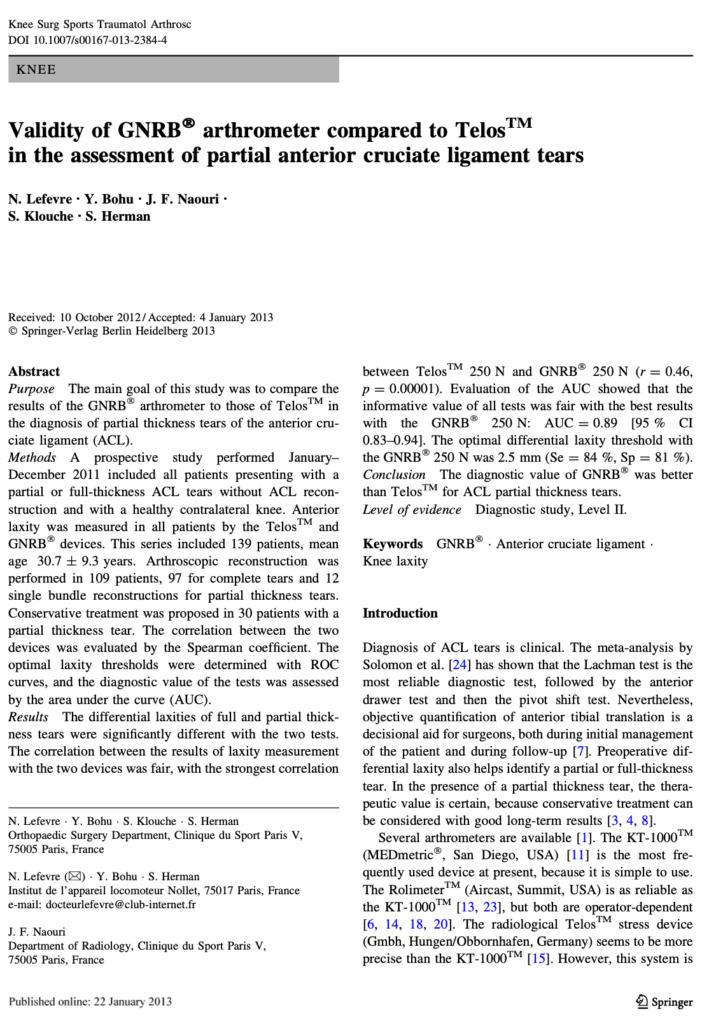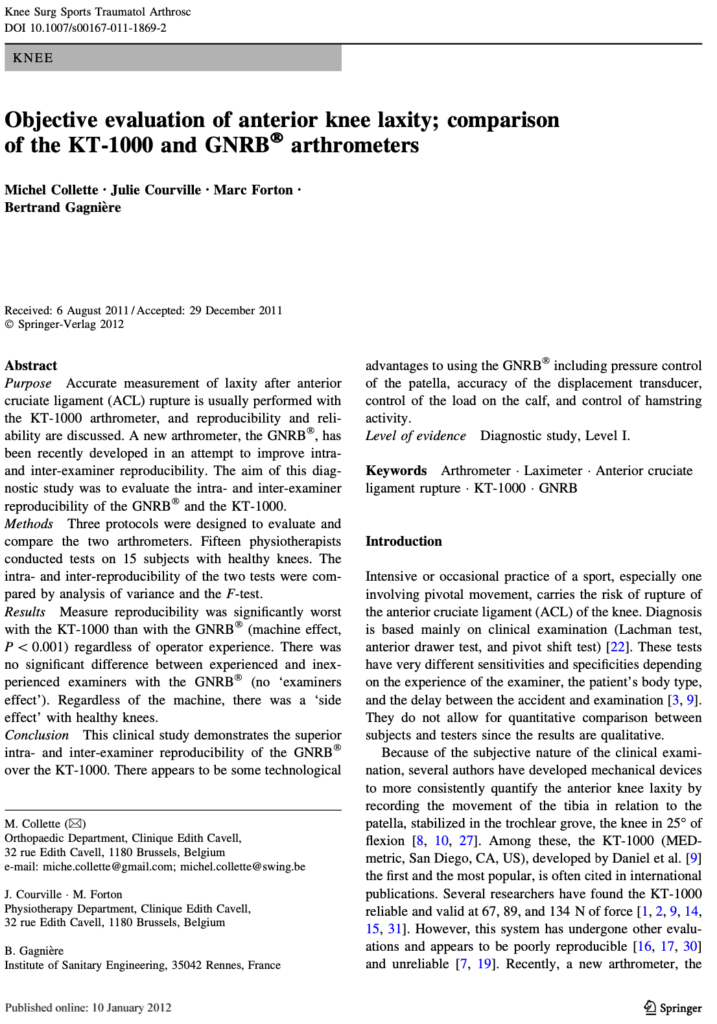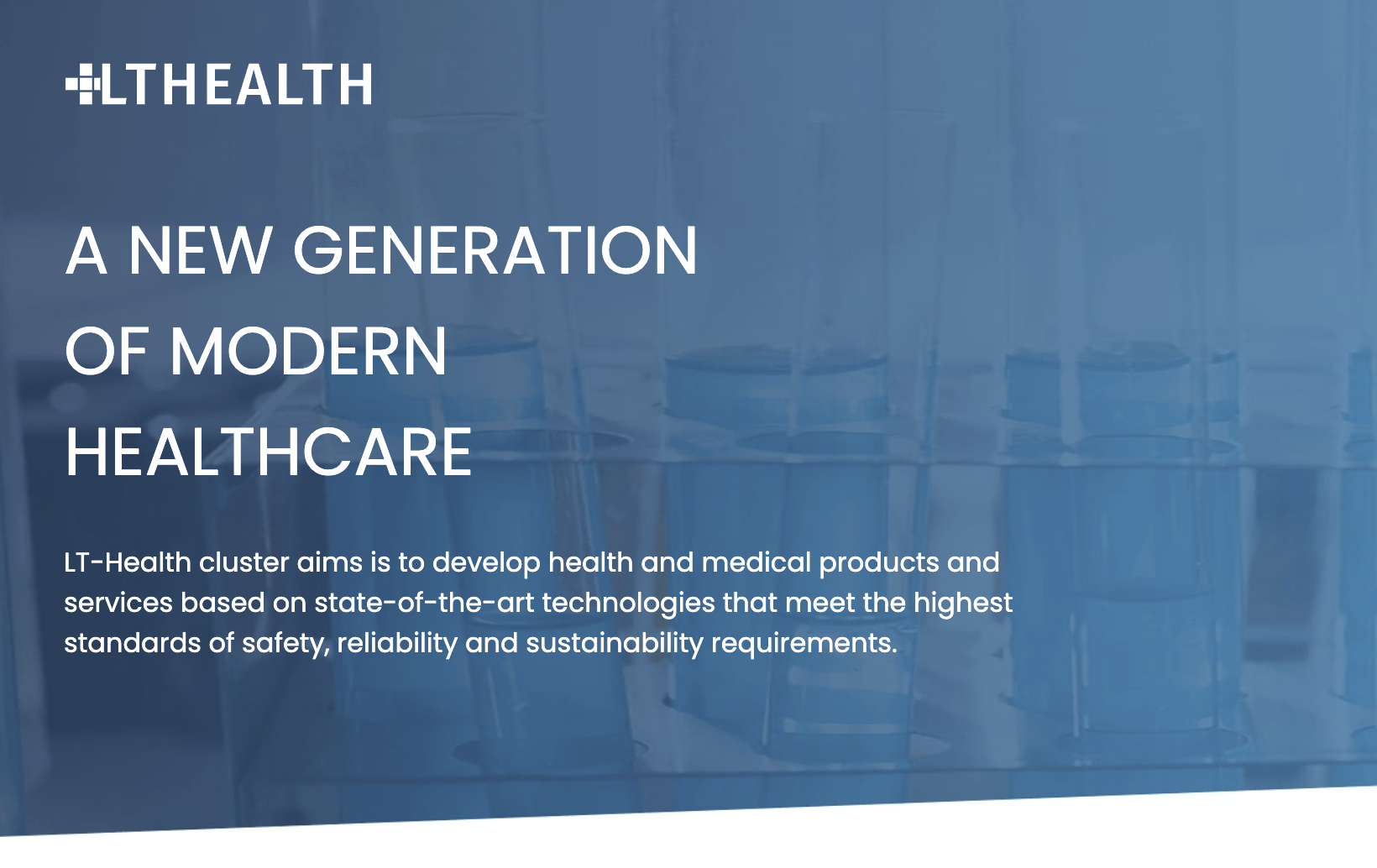Arthrometers are specialized medical devices used to assess ligament integrity, particularly the Anterior Cruciate Ligament (ACL), by measuring joint laxity. These tools are essential in orthopedic diagnostics, providing precise data that aid in diagnosing ligament injuries, planning surgeries, and monitoring postoperative recovery. Traditionally, manual arthrometers like the KT1000/KT2000, Rolimeter, Lachmeter, and Telos Stress Device have been widely used.
However, advancements in technology have led to the development of robotic/dynamic arthrometers such as the DYNEELAX® and GNRB®. These modern devices offer enhanced precision and additional diagnostic capabilities, making them invaluable in clinical settings. This article explores the various arthrometer options available on the market (Arthrometer Comparative Analysis Tables Chart), highlighting the evolution from manual to robotic systems and emphasizing the superior benefits of the latter.
I. Manual Arthrometers
1.1 KT1000/KT2000 (USA)
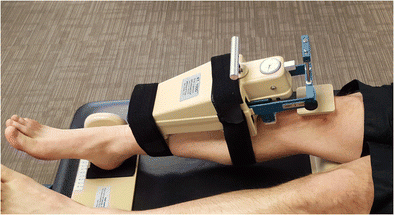
The KT1000 and KT2000 arthrometers are among the earliest devices developed for measuring anterior-posterior displacement of the knee, crucial in diagnosing ACL injuries. Introduced in the 1980s by Medmetric, these devices revolutionized the assessment of ligament laxity by providing quantifiable data rather than relying solely on clinical judgment. The KT1000 and its successor, the KT2000, gained widespread acceptance in clinical and research settings due to their simplicity and effectiveness.
However, these devices come with several limitations. The accuracy of measurements can be affected by patient muscle guarding and operator variability. Additionally, they require manual force application, which can lead to inconsistent results. Despite their historical significance, KT1000 and KT2000 units are no longer manufactured and are only available as second-hand units, limiting their accessibility and raising concerns about their condition and calibration.
Acquiring a KT1000 or KT2000 unit today is not without significant challenges and risks. Since these devices are no longer produced, any available units are second-hand, which poses several complications. The reliability and accuracy of these used devices are highly questionable, as they may suffer from wear and tear that affects their performance. Additionally, the lack of available parts and professional servicing options makes it difficult to ensure these devices are functioning correctly. Potential buyers must also contend with the fact that the calibration of these arthrometers could be significantly off, further compromising their diagnostic accuracy.
Given these issues, relying on second-hand KT1000 or KT2000 units can be particularly problematic in clinical practice, where precision and reliability are paramount. The inherent risks of using outdated and potentially faulty equipment make it clear that while the KT1000 and KT2000 have been valuable tools in the past, their practical utility in modern settings is severely limited. Thus, transitioning to newer, more reliable technologies is not just advisable but necessary for maintaining high standards of patient care.
1.2 Rolimeter (Switzerland)
The Rolimeter, manufactured in Switzerland, represents a significant advancement in manual arthrometry. Designed to measure anterior tibial translation, it is compact, easy to use, and portable, making it a popular choice for clinicians worldwide. The device uses a mechanical dial gauge to quantify knee laxity, providing a straightforward and reliable method for assessing ACL integrity.
One of the key benefits of the Rolimeter is its simplicity and ease of use, which reduces operator dependency and enhances measurement consistency. Its lightweight and portable design allows for use in various clinical settings, including outpatient clinics and sports facilities. However, like other manual arthrometers, the Rolimeter relies on the clinician’s ability to apply consistent force and interpret readings accurately, which can introduce variability. Additionally, while it is effective for measuring anterior tibial translation, it does not provide information on rotational stability.
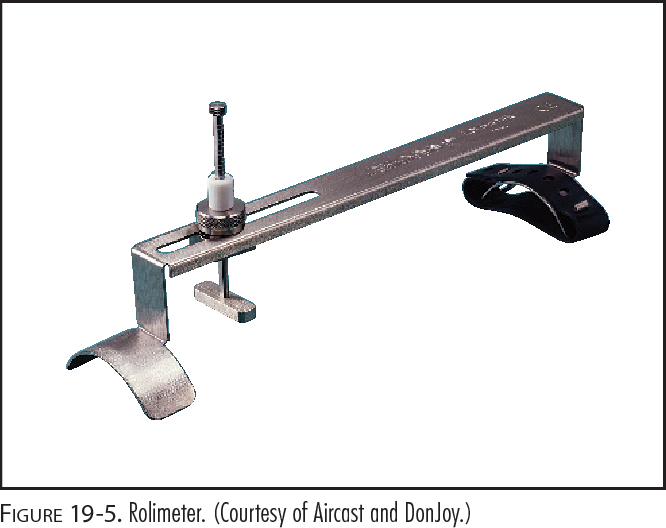
1.3 Lachmeter (Brazil)
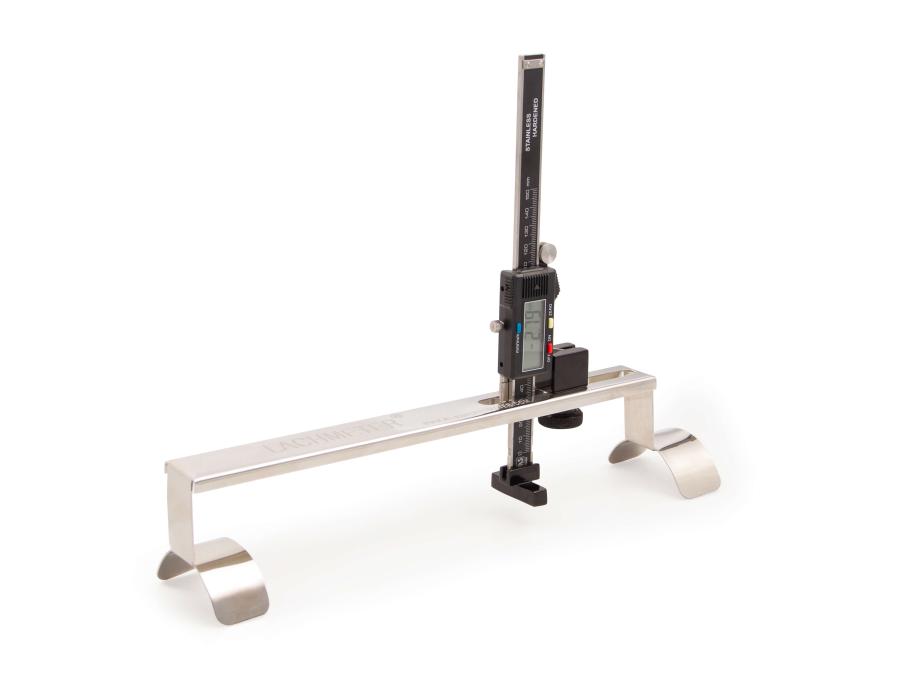
The Lachmeter, developed in Brazil, offers a digital approach to manual arthrometry. Similar in concept to the Rolimeter, it measures anterior tibial translation but includes a digital display for displacement measurement. This digital feature enhances precision and provides clear, quantifiable data, which can be easily recorded and compared over time.
The Lachmeter’s digital measurement system is a notable advancement over purely mechanical devices, reducing the likelihood of human error in reading and recording measurements. This makes it particularly useful in research settings where accuracy and repeatability are paramount. However, it shares some limitations with other manual devices, such as the need for consistent force application and operator training. Despite these challenges, the Lachmeter’s combination of mechanical simplicity and digital precision makes it a valuable tool in the assessment of ACL injuries.
1.4 Telos Stress Device (Germany)
The Telos stress device is unique among manual arthrometers due to its integration with radiology. This device applies a standardized force to the knee while radiographic images are taken, providing a visual and quantifiable assessment of joint stability. The involvement of radiology allows for precise measurement of joint laxity under controlled conditions, enhancing diagnostic accuracy.
Key features of the Telos stress device include its ability to provide objective data on ligament integrity and its use in both diagnostic and post-operative settings. However, the requirement for radiographic imaging limits its practicality to facilities equipped with the necessary imaging technology and may expose patients to additional radiation. Despite these limitations, the Telos stress device remains a valuable tool for comprehensive knee assessment, particularly in complex cases where detailed imaging is beneficial.
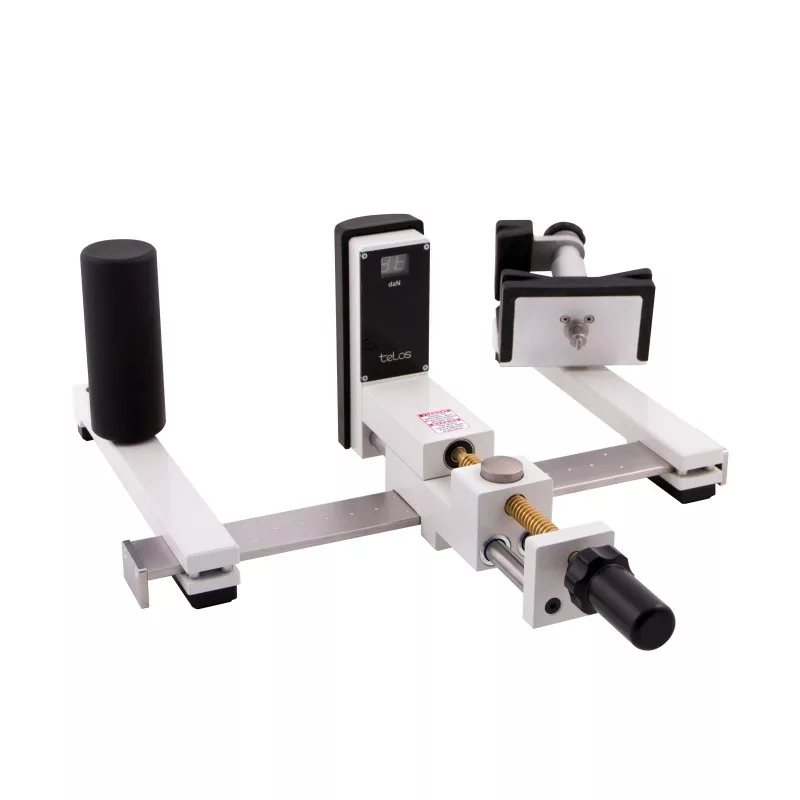
1.5 KLT Storz (Germany)

The KLT Storz Arthrometer is a manual device designed specifically for assessing knee stability by measuring anterior-posterior laxity. Manufactured by KARL STORZ, a company renowned for its high-quality medical devices, the KLT is intended for diagnosing injuries to the cruciate ligaments. The device is equipped with components like a tibial support, a patellar support, and a measurement piston, which allow for accurate and repeatable measurements of knee laxity. The KLT Arthrometer is particularly noted for its ability to perform critical tests, such as the Lachman test, which is essential in diagnosing both acute and chronic ACL injuries.
Despite its reliability and robust construction, the KLT Storz requires careful calibration and manual force application, which can introduce variability in results depending on the operator’s experience and technique. This device, although effective, is increasingly being outpaced by more advanced robotic systems that offer greater precision and consistency. However, for those seeking a traditional yet reliable arthrometer, the KLT Storz remains a viable option, especially in settings where advanced robotic alternatives may not be available.
1.6 KS MEASURE KSM-100 (Japan)
The KS Measure KSM-100 is a modern manual arthrometer specifically designed for evaluating the function of the cruciate ligaments by assessing the anterior-posterior stability of the knee joint. Manufactured by Nippon Sigmax, the KSM-100 is known for its lightweight and compact design, which makes it easy to transport and use across various clinical settings. One of the standout features of the KSM-100 is its digital display, which provides real-time visualization of load and displacement measurements, enhancing the accuracy and ease of data collection during knee stability assessments.
This device is equipped with several advanced features to ensure precise measurements. It includes a calibration tool (a 30N weight gauge) to maintain measurement accuracy, and a memory function that can store up to 24 test results. Additionally, the KSM-100 allows for data transfer via a USB connection, enabling clinicians to easily manage and analyze patient data on a computer. Despite its manual operation, the KSM-100 integrates these digital capabilities to minimize human error and improve the reliability of the results.However, like other manual arthrometers, the KSM-100 relies on the operator’s ability to apply consistent force during tests, which can introduce variability.
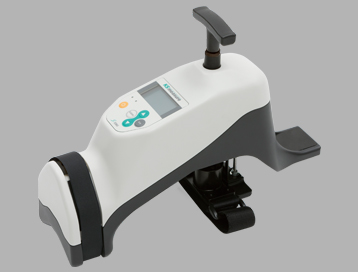
1.7 KiRA (Italy)

The KIRA Arthrometer by Orthokey is an advanced tool designed to assess knee stability, focusing on dynamic laxity during key tests like the Pivot Shift and Lachman tests. Unlike traditional arthrometers, KIRA incorporates a Bluetooth-enabled sensor that communicates with an iPad or iPhone via a dedicated app, allowing clinicians to perform real-time analysis of knee joint behavior. This setup provides instant visualization of both force and displacement, helping to detect and quantify ACL lesions with high precision. Its CE certification as a medical device underscores its reliability for both diagnostic and rehabilitation monitoring, making it a trusted option in orthopedic settings.
What sets KIRA apart is its ability to store and track patient data over time. The device enables clinicians to compare pathological knees with their healthy counterparts, offering a standardized and quantitative approach to evaluating knee stability. KIRA’s small, non-invasive, and portable design makes it ideal for use in both clinics and field environments, enhancing flexibility without compromising accuracy. The ability to export detailed reports and integrate with Electronic Health Records (EHR) further facilitates efficient documentation and follow-up, making it an excellent choice for long-term patient car.
Moreover, KIRA is a valuable tool not only for diagnostics but also for tracking functional recovery after ACL reconstruction surgery. By providing quantifiable feedback, KIRA helps clinicians and patients monitor the progress of rehabilitation, ensuring that treatment plans can be adjusted as needed. Its user-friendly interface and seamless data management system also reduce the likelihood of diagnostic errors, offering both professionals and patients greater confidence in the results. This combination of advanced technology, portability, and data-driven insights makes KIRA a groundbreaking solution for modern knee laxity assessments
1.8 Ligs Digital Arthrometer (China)
The Ligs Digital Arthrometer, developed by Innomotion, represents a significant innovation in the quantitative assessment of knee and ankle joint laxity. This portable and digital arthrometer is designed to provide precise measurements of anterior tibial translation (ATT) under controlled loading conditions, without the need for radiation exposure. Using built-in pressure and displacement sensors, the Ligs arthrometer can apply continuous loads up to 150 N and automatically record real-time knee laxity with an accuracy of 0.1 mm, making it highly reliable for diagnosing ACL injuries. The device generates a force-displacement curve, which helps clinicians evaluate ligament laxity and differentiate between injured and healthy knees with exceptional precision.
One of the Ligs’ unique features is its ability to offer simultaneous stress radiography, enabling a more detailed assessment when paired with radiological equipment. The receiver operating characteristic (ROC) curve analysis in studies has shown that the Ligs performs with high diagnostic accuracy, particularly at loads of 90 N, 120 N, and 150 N, with sensitivity and specificity values reaching over 85%. The versatility of the Ligs also extends to ankle joint assessments, making it a useful tool for both knee and ankle instability diagnoses.
In terms of clinical utility, the Ligs has demonstrated excellent intra- and interrater reliability, making it a trustworthy choice for ongoing patient monitoring. Its portability and non-invasive nature make it a practical solution for clinics looking to integrate advanced diagnostic tools without the drawbacks of radiation or manual force variability. The Ligs’ ability to quantitatively measure and track side-to-side differences (SSD) in joint laxity makes it particularly beneficial for clinicians aiming for precise and data-driven diagnostics in ACL rupture cases

1.9 Blu-Dat (Italy)

The Blu-DAT Arthrometer is a manual device manufactured by FGP Srl, based in Dossobuono, Verona, Italy, and designed for precise measurement of anterior-posterior knee laxity. Engineered with a focus on reliability and precision, the Blu-DAT is specifically crafted to assist in diagnosing injuries to the cruciate ligaments. Its robust design features components like a tibial support, a patellar support, and a calibrated measurement system, ensuring consistent and accurate measurements of knee laxity. The device is highly regarded for its effectiveness in performing critical tests, such as the Lachman test, which is vital for identifying both acute and chronic ACL injuries.
While the Blu-DAT Arthrometer delivers dependable results, it requires manual force application and a certain level of operator proficiency, which can introduce variability depending on the user’s technique and experience. Despite the rise of advanced robotic arthrometry systems, the Blu-DAT remains a trusted tool for practitioners in need of a reliable manual solution, particularly in settings where robotic alternatives may not yet be available.
II. Robotic/Dynamic Arthrometers
The evolution from manual to robotic arthrometers marks a significant advancement in orthopedic diagnostics. Robotic systems offer numerous benefits over traditional manual devices, including enhanced precision and accuracy, consistency in measurements, and ease of use. These advancements allow for more detailed and reliable assessments of ligament integrity, particularly in diagnosing ACL injuries. Robotic arthrometers provide comprehensive data that can significantly improve surgical planning and postoperative monitoring, leading to better patient outcomes.
2.1 GNRB (France)

The GNRB arthrometer is a state-of-the-art robotic device designed to measure anterior-posterior knee laxity with exceptional precision. It employs advanced robotic technology to apply controlled forces to the knee, ensuring consistent and accurate measurements of ligament displacement. This device is particularly effective in diagnosing partial ACL ruptures, which are often challenging to detect with manual methods.
Features and Technology: The GNRB utilizes a computer-controlled system that applies a precise and reproducible force to the knee. It measures the resulting tibial translation with high accuracy, providing detailed data on ligament integrity. The device is equipped with sensors that monitor the applied force and displacement in real-time, ensuring precise control and consistent results.
Precision and Accuracy in Measuring Translation: One of the standout features of the GNRB is its ability to measure tibial translation with exceptional accuracy. Studies have shown that the GNRB can detect even small degrees of laxity that might be missed by manual arthrometers. This high level of precision is crucial for accurately diagnosing partial ACL tears and planning appropriate treatment strategies.
Benefits Over Manual Arthrometers: The GNRB offers several advantages over manual arthrometers. Firstly, it reduces operator dependency, ensuring that measurements are consistent regardless of who operates the device. Secondly, the robotic system applies force in a controlled manner, minimizing the risk of measurement variability due to patient muscle guarding or improper technique. Lastly, the detailed data provided by the GNRB can be easily recorded and analyzed, facilitating long-term monitoring of ligament health.
Clinical Evidence and Studies: Numerous studies have validated the efficacy of the GNRB in clinical settings. Cojean (2023) highlighted the device’s ability to provide consistent and precise measurements, which are crucial for effective treatment planning. Notably, Cojean also asserted that the GNRB is superior to MRI in analyzing partial ACL ruptures, emphasizing its diagnostic accuracy and reliability. Smith (2022) found that the GNRB offers significant improvements in diagnostic accuracy compared to manual methods. Furthermore, Magdic (2023) confirmed the GNRB’s high intra-rater reliability, demonstrating its consistency in measuring knee anterior laxity in healthy, active subjects.
For rehabilitation, studies such as Nouveau (2017), Pouderoux (2019), and Forelli (2023) have shown the importance of the GNRB in monitoring ACL graft integrity and recovery. Nouveau (2017) emphasized the device’s role in assessing graft compliance during early postoperative periods, influencing final graft stiffness. Pouderoux (2019) noted that joint laxity and graft compliance could be effectively monitored, aiding in the adjustment of rehabilitation protocols. Forelli (2023) confirmed the GNRB’s utility in providing detailed insights into graft healing and helping to tailor rehabilitation strategies for optimal outcomes.
2.2 Dyneelax (France)
The DYNEELAX® arthrometer represents a groundbreaking advancement in ligament assessment technology. It is the first device to combine measurements of dynamic translation and tibial rotation, providing a comprehensive evaluation of knee stability. This dual-measurement capability offers unparalleled insights into ACL integrity and rotational stability, which are critical for effective surgical planning and postoperative monitoring.
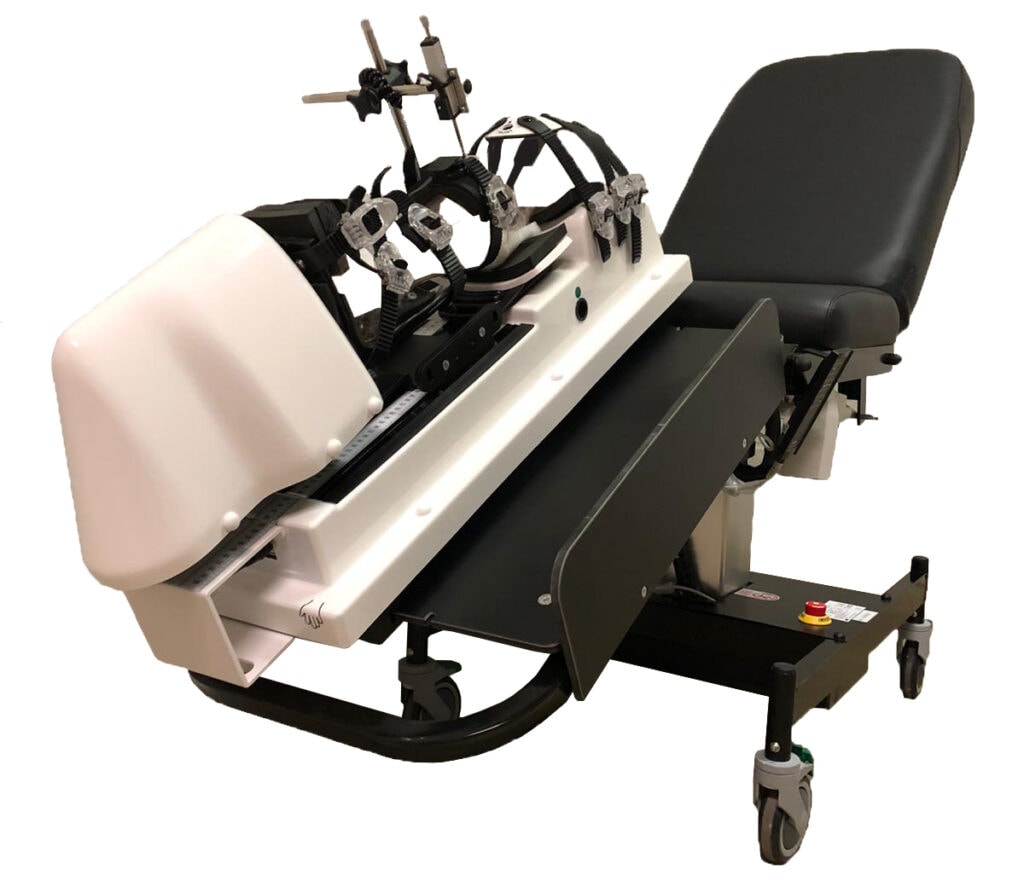
Features and Technology: Dyneelax utilizes a sophisticated robotic system that applies controlled forces to both translate and rotate the tibia. The device is equipped with high-precision sensors that capture detailed data on both translational and rotational movements. This comprehensive approach allows for a more complete assessment of ligament health and joint stability.
Measurement of Tibial Rotation (A First in History): Dyneelax is the first arthrometer to measure tibial rotation, a critical component of knee stability that is often overlooked by traditional devices. By assessing both translation and rotation, Dyneelax provides a more holistic view of ACL function, enabling clinicians to identify subtle instabilities that could affect patient outcomes.
Combination of Dynamic Translation and Rotation Results: The combination of dynamic translation and rotation measurements offers a more accurate and detailed assessment of knee stability. This dual approach helps to identify not only the degree of laxity but also the rotational integrity of the ACL. Such comprehensive data is invaluable for surgeons in planning precise surgical interventions and for monitoring postoperative healing.
Benefits for Surgical Planning and Postoperative Monitoring: The detailed data provided by Dyneelax enhances surgical planning by offering a clear understanding of both translational and rotational knee stability. Surgeons can tailor their procedures to address specific instabilities, leading to more effective repairs and improved patient outcomes. Additionally, Dyneelax can be used to monitor ACL graft integrity and healing progression one month post-operation, providing critical insights into the success of the surgery and guiding rehabilitation protocols.
Clinical Evidence and Studies: Clinical studies have demonstrated the effectiveness of Dyneelax in providing reliable and detailed assessments of knee stability. Cojean (2023) conducted a study on the sensitivity, repeatability, and reproducibility of Dyneelax, confirming its high reliability and precision in measuring knee laxity. Guegan (2024) performed a cadaveric study that highlighted the significant role of medial plane structures in controlling anterior tibial translation and tibial rotation, validated using the Dyneelax laximeter. Additionally, Nascimento (2024) documented the reliability and feasibility of Dyneelax in both healthy and ACL-injured/reconstructed individuals, demonstrating excellent intrarater reliability for all measured metrics.

III. Arthrometer Comparative Analysis
3.1 Manual vs. Robotic Arthrometers
Precision and Accuracy: Manual arthrometers, such as the KT1000 and Rolimeter, provide valuable insights but are limited by operator dependency and variability in force application. Studies such as Collette et al. (2012) have shown that the KT1000 and GNRB provide comparable laxity measurements, but the GNRB demonstrates higher precision due to its robotic control. Lefevre et al. (2013) compared the GNRB and Telos devices, finding the GNRB more effective, especially in partial ACL tear diagnosis. Murgier et al. (2018) further supports that the GNRB and KT1000 are more similar in their laxity measurements than other manual devices.
Ease of Use: While manual arthrometers are generally straightforward to use, they require significant operator training and experience to achieve reliable results. Robotic arthrometers simplify the process by automating force application and measurement, making them easier to use and less dependent on operator skill. This reduction in variability is crucial for consistent and accurate diagnostics.
Clinical Applications: Manual arthrometers have traditionally been used in both clinical and research settings for ACL injury assessment. However, their limited precision can impact their utility in complex cases. Robotic arthrometers, with their high accuracy and detailed data, are increasingly favored for diagnosing partial ACL ruptures, planning surgeries, and monitoring postoperative recovery. Ryu et al. (2018) highlighted the advantages of robotic devices like the GNRB over traditional methods in providing detailed and reproducible data for clinical use.
Limitations and Advancements: Manual arthrometers are limited by their mechanical nature and the need for consistent operator technique. Despite their historical significance, they are being eclipsed by robotic systems that offer advancements in precision, ease of use, and comprehensive data collection. Robotic arthrometers continue to evolve, incorporating features such as tibial rotation measurement, further enhancing their clinical value.
3.2 Impact on Patient Outcomes
Diagnostic Accuracy: The high precision of robotic arthrometers leads to improved diagnostic accuracy, particularly in detecting partial ACL ruptures and subtle instabilities that manual devices might miss. This accuracy is critical for determining the appropriate treatment pathway. Cojean (2023) demonstrated that the GNRB is superior to MRI in analyzing partial ACL ruptures, emphasizing its diagnostic accuracy and reliability. Klasan et al. (2019) found that different laximeters, including robotic ones, significantly influence anterior knee translation measurements post-ACL reconstruction, emphasizing the superior diagnostic capabilities of robotic devices.
Surgical Planning and Outcomes: Robotic arthrometers provide detailed data on knee laxity and stability, aiding surgeons in planning more precise and effective interventions. The combination of dynamic translation and rotation measurements allows for a comprehensive understanding of the knee’s condition, which can improve surgical outcomes. Beldame et al. (2012) and Lefevre et al. (2013) demonstrated that the GNRB is particularly useful for surgical planning due to its high sensitivity and specificity in detecting ACL tears. Guegan (2024) emphasized the role of robotic arthrometers in accurately assessing the role of medial plane structures in controlling knee stability, aiding in precise surgical interventions.
Postoperative Monitoring and Rehabilitation: The ability of robotic arthrometers to monitor ACL graft integrity and healing progression one month post-operation is invaluable. This ongoing assessment helps tailor rehabilitation protocols to the patient’s specific needs, promoting optimal recovery and reducing the risk of re-injury. Studies by Nouveau (2017), Forelli (2023), Pouderoux (2019), and Semay (2016) have demonstrated the utility of the GNRB in postoperative evaluations, showing that detailed monitoring with robotic arthrometers can significantly enhance rehabilitation outcomes and ensure the long-term success of ACL surgeries.
Conclusion
Manual arthrometers, such as the KT1000 and Rolimeter, have long been used in ACL injury diagnostics, providing valuable insights despite their limitations due to operator variability and mechanical constraints. However, the emergence of robotic arthrometers like GNRB and Dyneelax has revolutionized this field. These advanced devices offer unparalleled precision, consistency, and detailed data, significantly enhancing diagnostic accuracy, surgical planning, and postoperative monitoring. The DYNEELAX® and GNRB®, for instance, have been proven superior in detecting partial ACL ruptures and are highly reliable in postoperative assessments.
As robotic technology continues to advance, incorporating enhanced sensors and integration with imaging techniques, the precision and reliability of ligament assessments will only improve. This progress promises even better patient outcomes and more personalized treatment plans, marking a significant leap forward in orthopedic diagnostics and rehabilitation.
Clinicians are encouraged to adopt robotic arthrometers like DYNEELAX® and GNRB® due to their significant benefits for both clinicians and patients. These advanced devices offer unmatched precision, consistency, and comprehensive data, improving diagnostic accuracy, surgical planning, and postoperative monitoring. By integrating robotic arthrometers into practice, clinicians can provide superior care and enhance patient outcomes. We invite you to learn more about these innovative tools and consider how they can transform your orthopedic diagnostics and treatment protocols, ultimately leading to more personalized and effective patient care.
Medical References
- Cojean T, Batailler C, Robert H, Cheze L. (2023). GNRB® laximeter with magnetic resonance imaging in clinical practice for complete and partial anterior cruciate ligament tears detection: A prospective diagnostic study with arthroscopic validation on 214 patients. Knee, 42, 373-381. DOI: 10.1016/j.knee.2023.03.017
- Smith K, Miller N, Laslovich S. (2022). The Reliability of the GNRB® Knee Arthrometer in Measuring ACL Stiffness and Laxity: Implications for Clinical Use and Clinical Trial Design. Int J Sports Phys Ther, 17(6), 1016-1025. DOI: 10.26603/001c.38252
- Magdić M, Gošnak Dahmane R, Vauhnik R. (2023). Intra-rater reliability of the knee arthrometer GNRB® for measuring knee anterior laxity in healthy active subjects. Journal of Orthopaedics. DOI: 10.1016/j.jor.2023.03.016
- Nouveau, S., Robert, H., Viel, T. (2017). ACL Grafts Compliance During Time: Influence of Early Solicitations on the Final Stiffness of the Graft after Surgery. Journal of Orthopedic Research and Physiotherapy, 3(1), 035. DOI: 10.24966/ORP-2052/100035
- Pouderoux, T., Muller, B., Robert, H. (2019). Joint laxity and graft compliance increase during the first year following ACL reconstruction with short hamstring tendon grafts.. DOI: 10.1007/s00167-019-05711-z
- Forelli F, Le Coroller N, Gaspar M, et al. (2023). Ecological and Specific Evidence-Based Safe Return To Play After Anterior Cruciate Ligament Reconstruction In Soccer Players: A New International Paradigm. IJSPT. Published online April 2, 2023. DOI: 10.26603/001c.73031
- Cojean, T., Batailler, C., Robert, H., Cheze, L. (2023). Sensitivity repeatability and reproducibility study with a leg prototype of a recently developed knee arthrometer: The DYNEELAX®. Medicine in Novel Technology and Devices, 19, 100254. DOI: 10.1016/j.medntd.2023.100254
- Guegan, T. (2024). All the menisco‐ligamentary structures of the medial plane play a significant role in controlling anterior tibial translation and tibial rotation of the knee. Cadaveric study of 29 knees with the Dyneelax® laximeter.
- DOI: 10.1002/jeo2.12038
- Nascimento, N., Kotsifaki, R., Papakostas, E., Zikria, B. A., Alkhelaif, K., Hagert, E., Olory, B., D’Hooghe, P., & Whiteley, R. (2024). DYNEELAX Robotic Arthrometer Reliability and Feasibility on Healthy and Anterior Cruciate Ligament Injured/Reconstructed Persons. Translational Sports Medicine, 2024(1), 1-5. DOI: 10.1155/2024/3413466
- Collette, M., Courville, J., Forton, M., & Gagnière, B. (2012). Objective evaluation of anterior knee laxity; comparison of the KT-1000 and GNRB arthrometers. Knee Surg Sports Traumatol Arthrosc. DOI: 10.1007/s00167-011-1869-2
- Lefevre, N., Bohu, Y., Naouri, J.F., Klouche, S., & Herman, S. (2013). Validity of GNRB arthrometer compared to Telos in the assessment of partial anterior cruciate ligament tears. Knee Surgery, Sports Traumatology, Arthroscopy, 22, 285-290. DOI: 10.1007/s00167-013-2384-4
- Murgier, J., Béranger, J.S., Boisrenoult, P., Steltzlen, C., & Pujol, N. (2018). Prospective comparative study of knee laxity with four different methods in anterior cruciate ligament tears. International Orthopaedics (SICOT). DOI: 10.1007/s00264-018-3791-4
- Ryu, S. M., Na, H. D., & Shon, O. J. (2018). Diagnostic Tools for Acute Anterior Cruciate Ligament Injury: GNRB, Lachman Test, and Telos. Knee Surgery & Related Research, 30(2), 121-127. DOI: 10.5792/ksrr.17.014
- Klasan, A., Putnis, S.E., Kandhari, V., Oshima, T., & Parker, D.A. (2019). Anterior knee translation measurements after ACL reconstruction are influenced by the type of laximeter used. Knee Surgery, Sports Traumatology, Arthroscopy. DOI: 10.1007/s00167-020-05950-5
- Beldame, J., Mouchel, S., Bertiaux, S., Adam, J.M., Mouilhade, F., Roussignol, X., & Dujardin, F. (2012). Anterior knee laxity measurement: Comparison of passive stress radiographs Telos® and ‘‘Lerat’’, and GNRB® arthrometer. Orthopaedics & Traumatology: Surgery & Research, 98, 744-750. DOI: 10.1016/j.otsr.2012.05.017
- Semay, B., Rambaud, A., Philippot, R., Edouard, P. (2016). Evolution of the anteroposterior laxity by GnRB at 6 9 and 12 months post-surgical anterior cruciate ligament reconstruction. DOI: 10.1016/j.rehab.2016.07.045

